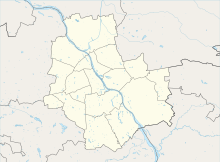Confederation Square (Polish: Plac Konfederacji) is an urban square in Warsaw, Poland. It is located in the district of Bielany, at the crossing of Płatnicza Street, Lipińska Street, Schroegera Street, and Daniłowskiego Street. The square was built in the late 1920s.[1]
 Confederation Square in 2017 | |
| Location | Warsaw, Poland |
|---|---|
| Coordinates | 52°16′47.2″N 20°56′47.7″E / 52.279778°N 20.946583°E |
| North | Lipińska Street Płatnicza Street |
| East | Schroegera Street |
| South | Daniłowskiego Street Płatnicza Street |
| West | Schroegera Street |
| Construction | |
| Completion | 1920s |
Name
editThe park was named after confederations, which were special associations formed by nobility in the Polish–Lithuanian Commonwealth. The most famous of those were the Bar Confederation formed in 1768, and the Targowica Confederation in 1792.[2]
History
editThe square was constructed in the late 1920, beginning in 1926. It was built as a part of the then-developed suburban neighbourhood of Zdobycz Robotnicza in Warsaw. Around it, 27 detached houses, designed by Janusz Dzierżawski in the manor house style, were built.[1][3]
Between 1953 and 1954, next to the square, several terraced houses, designed by Maria Piechotek and Kazimierz Piechotek, were built.[1]
In 1981, next to the square, the Church of St. Sigismund, designed by Zbigniew Pawelski, was built.[3]
Characteristics
editConfederation Square is a small rectangular urban square, located at the crossing of Płatnicza Street, Lipińska Street, Schroegera Street, and Daniłowskiego Streets. It has the area 0.70 ha.[1]
In its centre, there is a monument dedicated to the 77th Infantry Regiment of the Polish Armed Forces, and the 77th Infantry Regiment of the Home Army, both of which served during the Second World War. It is shaped like a rock with an institution sculpted on it.[1][3]
References
edit- ^ a b c d e Paweł Brylski (2017). "Plac Konfederacji". placewarszawy.pl (in Polish).
- ^ "Plac Konfederacji". ulicetwojegomiasta.pl (in Polish).
- ^ a b c Tomasz Urzykowski (17 May 2007). "Stare Bielany". warszawa.wyborcza.pl (in Polish).
